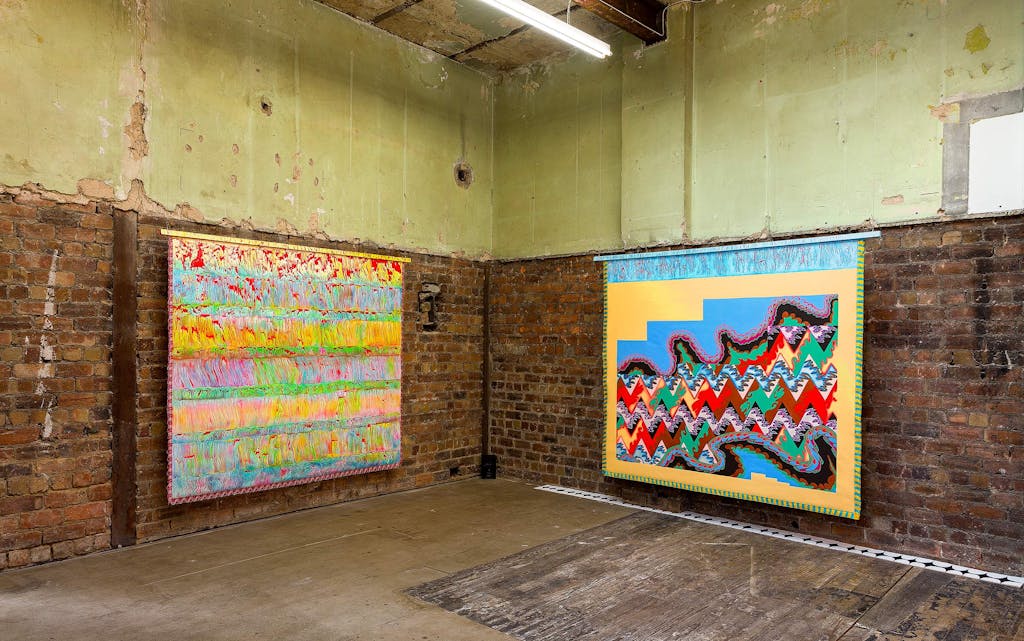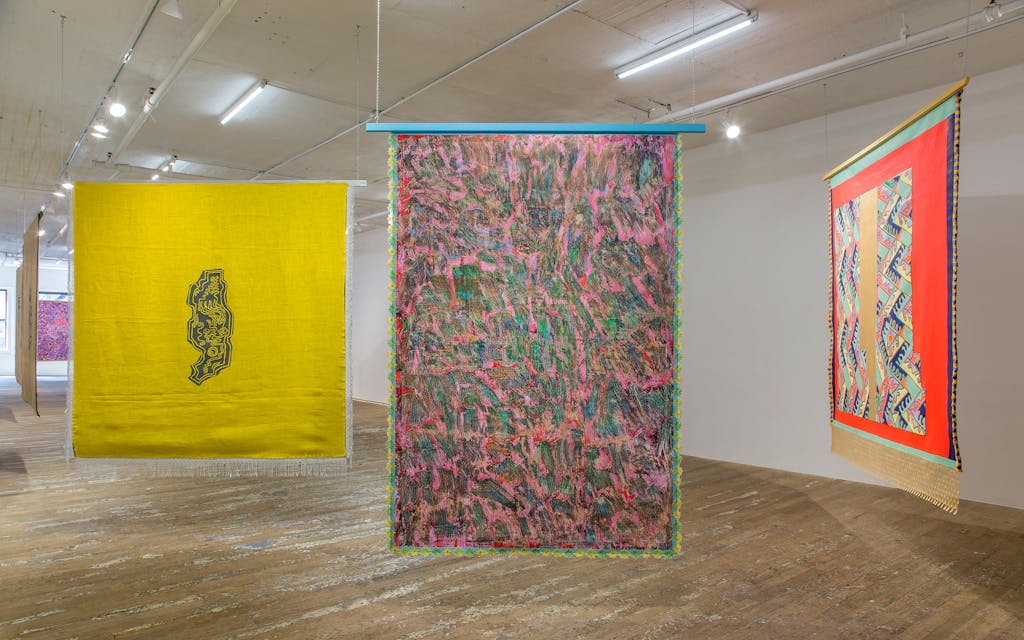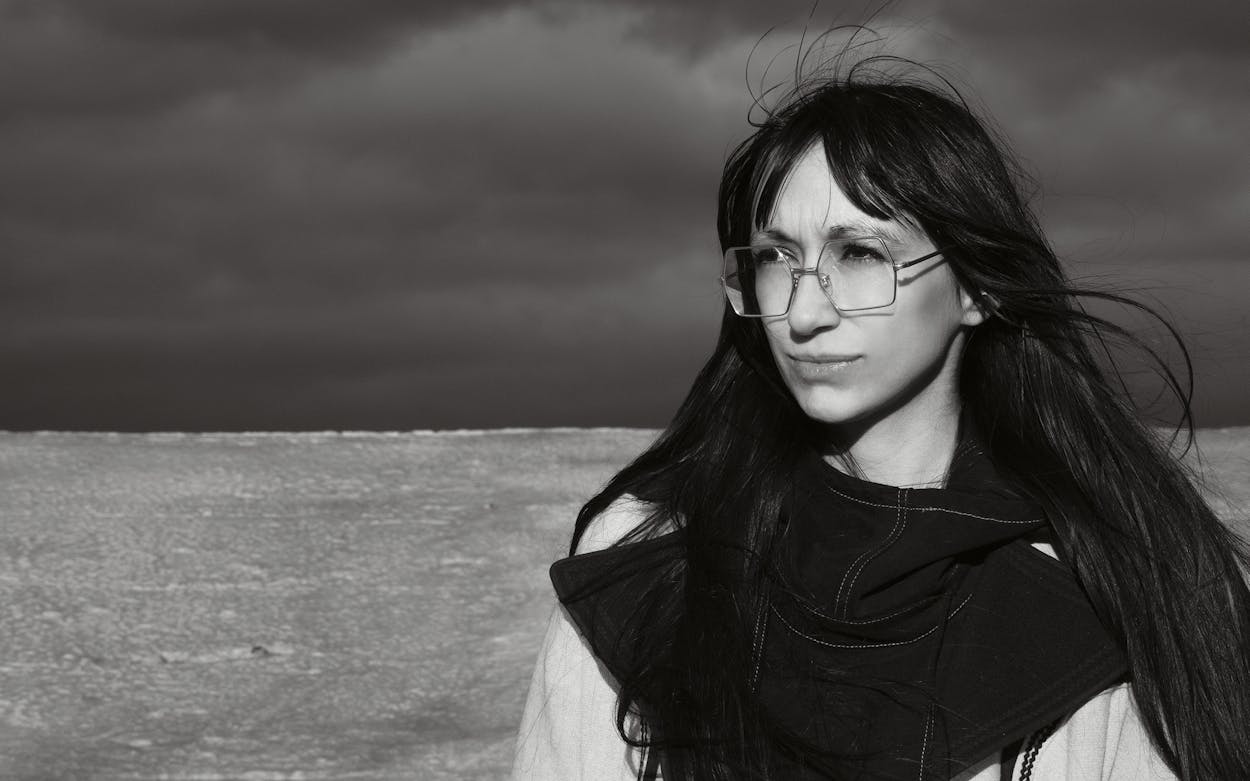When visual artist Lisa Alvarado seeks inspiration, she’s inevitably drawn back to her grandmother’s house on the South Side of San Antonio, where she spent much of her childhood. Painted in glowing pastels and smelling of botanica candles, the home had an outsized impact on her life and work. “My welita created colorful laces and stitched fabrics that were wrapped upon all of her surfaces: tables, pillows, couches, and all changed out frequently,” Alvarado says via Zoom from her home studio this past winter. Not that it’s easy to tell it’s her painting studio, as there’s nothing but bare walls behind her. You’d think she was in the process of moving, empty as it is. But after she spent a feverish few weeks finishing preparations for her first U.K. solo exhibition, which ran from February to April at Glasgow’s Modern Institute, her latest works have all been packed up by movers and shipped across the Atlantic. The sun-bright colors and zigzagging patterns of her large canvases are nowhere to be seen. Only her unkempt long black hair and chipped nail polish suggest the demands of a recent deadline.
If it were any other time, Alvarado would next turn her attention to a set of paintings for the Dallas Symphony Orchestra’s Soluna International Music & Arts Festival, where they were going to be exhibited alongside the work of renowned American minimalist artist Ellsworth Kelly. (The show has been postponed.) The festival, which was going to be capped by a performance by Natural Information Society—Alvarado’s band with her husband and creative partner, Joshua Abrams—would have coincided with the band’s new album, Descension (Out of our Constrictions), recorded with British jazz legend Evan Parker.

Even as the pandemic keeps art events at a distant horizon, Alvarado has emerged as one of the brightest rising Mexican American artists. Her work has been shown at New York’s prestigious Frieze Art Fair, which has hosted the likes of Andy Warhol, Ed Ruscha, and James Rosenquist, and a 2017 exhibition had the New York Times hailing her as “a painting star.” Most recently, she had a flag piece up as part of Ballroom Marfa’s “unFlagging” exhibition. Her yellow flag had a pattern evoking a snake or a river, calling to mind the Rio Grande and flapping in the West Texas wind like a rattler come to life. “I see Alvarado as part of a long-overdue appreciation for the political possibilities and nuances of abstraction,” Jillian Steinhauer, a freelance cultural critic for the New York Times, writes via email. “Particularly when it’s made by artists of color who are looking at historical traditions and pushing back on the restrictiveness of a white, Western canon.”
Alvarado’s work is recognizable at a glance. The eye-catching, poppy colors she uses evoke Modernist paintings, but the intricate handmade patterns suggest Mexican and Tibetan textile work spanning centuries. “Painting for me is a process of guiding liquid to a solid state,” she says. “The fluidity of paint moves with gravity and solidifies with time.”
As we chat, she holds up her well-worn copy of Painting and Performance, scholar Victor Mair’s book about the intersection of art and oral storytelling in ancient China and India. Looking at her canvases, you get the feeling that you can see more the longer you gaze at them. Lines start to slip, patterns teem, sharp angles shift, colors brighten, curled paint starts to loosen its coil, your eye imagining just how the shapes might move if they weren’t fixed in paint. In exhibition spaces, the oversized pieces exude a distinctive sense of presence, often hanging from the center of the room so that they feel more like sculptures and three-dimensional pieces that viewers can observe in space. “When a work leaves the studio, it looks completely different from one place to another,” she says of her work. “It’s more like a living thing.” Alvarado compares her canvases to another daily activity. “It’s like going for a long walk: seeing many leaves falling into the street or water, some look different, some look the same,” she says. “The steps and breaths are similar, but each moment something comes along that’s a little different.”


The second of three children, Alvarado grew up on the South Side of San Antonio in the early eighties. Both sides of her family have roots in San Antonio and Laredo since before Texas was a part of the Union. She says her love of art and the transformational nature of it stems from a ritual she performed as a child in her backyard, putting “leaves, flowers, cicada skins, butterfly wings, crayons, Head & Shoulders [shampoo], and whatever was found at that moment inside clear ziplock bags,” she says. “I would then hide them and visit them each day, singing over them and watching them mix and transform over time.”
In middle school, Alvarado’s art manifested primarily in decorating the clear school binders of her classmates. A friend’s boyfriend turned her on to the possibilities of graffiti art; soon she was taking in low-rider shows at Rosedale and Camargo parks, plus live salsa band nights at small South Side restaurants. By the time she was a student at Oliver Wendell Holmes High School, she was invited to be in an after-school talent art program at the Blue Star Arts Complex in Southtown.
In her senior year of high school, a friend burned Alvarado a CD of John Coltrane’s lone live performance of the jazz classic A Love Supreme, a moment that opened up a new realm of possibilities for the budding artist. “It was like a direct transference of energy that could … recalibrate the spirit,” she says, adding that it made her into a metaphysical quester, a quality that stays with her to this day. “I wanted the path of my work to stay close to what I heard in that recording.”
She enrolled at San Antonio College and became enamored with Con Safo, the late-sixties Chicano art group whose members went on to teach at SAC. As the students painted, her professors sometimes played a soundtrack that ranged from minimalist composer Steve Reich to jazz drummer Max Roach. “The level of discipline and depth at SAC taught me how to be an artist,” she says.
But Alvarado soon felt like she had exhausted all that San Antonio had to offer. Two years into her studies, she transferred to the School of the Art Institute of Chicago, where she finished her BFA and became enamored with the Windy City’s bustling music scene. She caught as many jazz shows as she could and saw a tall, lanky bass player at almost every concert, playing onstage and mingling with the crowd. “I kept seeing Joshua around town, and he would ask me about whatever book I had with me,” she says of encountering Abrams, her future husband. One conversation led to another: “It was nourishing. We could both easily relate about our respective creative processes. Right away, he appreciated my work. And his music was outstanding to me.”
A native of Philadelphia, Abrams has long been a force on the Chicago music scene, his bass resounding on everything from post-rock bands Tortoise and Godspeed You! Black Emperor to singer-songwriter Will Oldham and the Roots’ first album. Most recently, Abrams appeared on the soundtrack for Michelle Obama’s Becoming. “Her work struck me as highly original, conveying … a perception mixed with a strong innate sense of rhythm and timing,” Abrams writes via email. “She also shares my appreciation of slowness and blur.”

Abrams and Alvarado were soon living and working in close proximity. Even though she had never been in a band before didn’t play an instrument, Abrams insisted she start making music with him. Alvarado’s large-scale paintings became the visual backdrop for performances by their group, Natural Information Society. The band was rooted in the practice of jazz improvisation, but also contained elements of Chicago post-rock and minimalism. Amplified by Alvarado’s visual work and her presence on the harmonium, the music could feel deep-focused and diffuse at once. “I would just look at her works for a long time and just be mystified by them,” says percussionist and NIS member Hamid Drake. Drake’s career stretches back to the heyday of spiritual jazz, when he would perform with the likes of saxophonist Pharoah Sanders, pianist Herbie Hancock, and former Ornette Coleman trumpeter Don Cherry and his wife, Moki Cherry.
It’s the latter artists who come to mind as Drake discusses Abrams and Alvarado. In the late seventies, the Cherrys lived a nomadic existence and toured the world, drawing on the spontaneity of jazz improvisation to weave together elements of African, Indian, Brazilian, and Scandinavian music, with Don playing trumpet and Moki accompanying him on Indian tambura. Their ecstatic performances were heightened by Moki’s vivid artworks hanging behind the band onstage. Such visuals were integral to the musical performance, according to Drake. “Her tapestries allowed viewers and listeners to draw them into the dynamic of what’s happening sonically,” he says. “It heightened their perception of both and enabled the journey to be a little deeper.” A similar phenomenon was happening with Abrams and Alvarado, he felt.
Alvarado also began to dig into her own family heritage. On a visit back home in 2007, she realized the art to be found in everyday objects, like serape blankets. “My parents would bring out gigantic blankets when the temperatures dropped. I started paying more attention to the textiles and realized their historical and artistic depth,” she says. … “Too often, the work of Mexican American artists is left out of institutional narratives of fine art and categorized as folk art.”
Growing up, Alvarado had always heard two family stories that were seemingly at odds with each other. In one, her father talked about living on a ranch his family had owned in Laredo for generations. And yet he also told hardscrabble stories about a boyhood as a migrant farm worker, his fingers bleeding from picking cotton, uprooted and always moving throughout the Southwest. “But what happened in between that? What happened to their old home and farm?” she wonders. “I had these little pieces of the story, but it wasn’t talked about very much. I once asked my dad specifically, ‘Why did your family have to leave?’ and he finally said: ‘Mexican repatriation.’”
Rarely discussed in United States history books, and barely known in Texas, Mexican repatriation marks an abysmal period between 1929 and 1936 when the U.S. deported, by some estimates, upwards of two million people to Mexico, in what some modern scholars call an act of ethnic cleansing. Conservative estimates surmise that nearly 60 percent of those forced out of the country were actually U.S.-born American citizens illegally removed from their homes and properties, their ethnicity the sole driver for their banishment. The generational setback affected Alvarado’s family deeply, and those with memories of that time were disinclined to talk about it. “They lost everything from the expulsion and eventually came back to work as migrant farm laborers,” she says. So when news of family separations taking place at the Texas border hit the news, it was especially traumatic for Alvarado. “Thinking about those separations now resonates with the painful events from decades ago.”

Her 2020 solo exhibition in New York City, “Thalweg,” found Alvarado pivoting from abstraction toward matters much closer to home. Using a geographical term that describes the lowest elevation point in a waterway that defines the boundary line between states, she meditated on how a border between two countries (much like the one separating the United States and Mexico) can be rigid while at the same time being, in Alvarado’s words, “This fluid thing and always transforming.” While the mesmerizing patterns and swirling colors of her prior works were still on radiant display, Alvarado introduced old photos of her grandmother and great-uncle to her canvases. Providing a grounding to the exhibition, it also put a human face on these otherwise dehumanizing forces that still act on thousands of people.
Fittingly, Alvarado’s visual work roves far beyond the confines of an art gallery. Her paintings served as backdrop for Natural Information Society performances at Pitchfork Fest and NYC’s Winter Jazzfest in years past, and can roll up in the back of the couple’s Volvo when they go out on tour. They are also featured on all of the band’s album covers to date, their vivid, mesmerizing patterns a perfect accompaniment for the music within, a mixture of spiritual jazz and minimalism that suggests Steve Reich and Pharoah Sanders. Since Alvarado and her harmonium became foundational to the group, its sound has slowly evolved, moving away from jazz toward something allowing for more space and calm within the music. Much like her visual art, the music allows those who encounter it to take a pause and contemplate.
“There’s a long history throughout the U.S.—and ancient cultures—of artists from different disciplines coming together to use sound and light to take us to a certain place that can help us move a little bit beyond ourselves,” Drake says.
For now, Alvarado is looking forward to getting back on the road and visiting her family in Texas again. “I do miss just being on tour and the energy of the performances, that kind of exchange,” Alvarado says. In this time of lockdowns and isolation, Alvarado’s art feels all the more transportive and transformative. Through it, you gaze deeper and feel yourself move.
- More About:
- Music
- Art
- San Antonio






